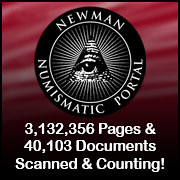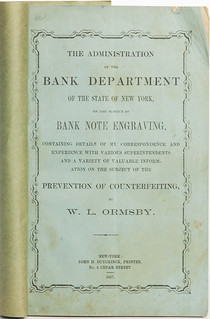
About UsThe Numismatic Bibliomania Society is a non-profit association devoted to the study and enjoyment of numismatic literature. For more information please see our web site at coinbooks.org SubscriptionsThose wishing to become new E-Sylum subscribers (or wishing to Unsubscribe) can go to the following web page link MembershipThere is a membership application available on the web site Membership Application To join, print the application and return it with your check to the address printed on the application. Print/Digital membership is $40 to addresses in the U.S., and $60 elsewhere. A digital-only membership is available for $25. For those without web access, write to: Charles Heck, Treasurer AsylumFor Asylum mailing address changes and other membership questions, contact Chuck at this email address: treasurer@coinbooks.org SubmissionsTo submit items for publication in The E-Sylum, write to the Editor at this address: whomren@gmail.com
BUY THE BOOK BEFORE THE COINSale Calendar
|
- WAYNE'S WORDS: THE E-SYLUM SEPTEMBER 6, 2020
- 2020 NBS BENEFIT AUCTION RESULTS
- NEW BOOK: WASHINGTON ON COINS AND CURRENCY
- NEW BOOK: HESSIAN COINS AND MEDALS
- NEW BOOK: NEW ZEALAND MEDALS 1939-40
- NEW BOOK: DISNEY NUMISMAGIC
- NEW BOOK: A GUIDE BOOK OF COLLECTIBLE POSTCARDS
- RICHARD J. PLANT (1928-2020)
- ANS CHAPMAN-TREMBLAY CORRESPONDENCE DIGITIZED
- VIDEO: IRAJ SAYAH INTERVIEW
- VIDEO: RON GUTH DISCUSSES ALICE PAUL
- NOTES FROM E-SYLUM READERS: SEPTEMBER 6, 2020
- CONFEDERATE TREASURY MEXICAN COIN
- STANDING LIBERTY GAME COUNTERS
- ORMSBY'S 1857 BANK NOTE ENGRAVING PAMPHLET
- VOCABULARY TERM: MONEYER
- FERGUSON HAINES (1840-1925)
- ANS SEEKS CURATORIAL ASSISTANT
- STEPHEN ALBUM RARE COINS AUCTION 38
- NUMISMAGRAM MEDAL SELECTIONS: SEPTEMBER 2020
- ARTIST RENDERINGS OF SRI LANKA TOKEN IMAGES
- CHINESE SPECIMEN SILVER COINS OFFERED
- AMAZONIAN TWENTY DOLLAR ALUMINUM PATTERN
- ASSAY OFFICE EAGLE FRACTIONAL GOLD PIECE
- THE LAST ENCASED POSTAGE STAMP ISSUER
- AUSTRALIA'S DONATION DOLLAR
- HOW AMERICA FELL INTO A GREAT COIN SHORTAGE
- TSA REPORTS FINDING $1M IN MISPLACED CASH
- TRAS ISLES MICRONATION BANKNOTES
- MONEY ART IN CANCELLED WHITNEY EXHIBIT
- 375-YEAR-OLD TREE SURVIVES HURRICANE
- LOOSE CHANGE: SEPTEMBER 6, 2020
Click here to access the complete archive
Click here to unsubscribe (scroll down)
To comment or submit articles, reply to whomren@gmail.com
Content presented in The E-Sylum is not necessarily researched or independently fact-checked, and views expressed do not necessarily represent those of the Numismatic Bibliomania Society.
WAYNE'S WORDS: THE E-SYLUM SEPTEMBER 6, 2020
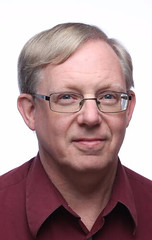 New subscribers this week include:
Mark Baldwin and
James Gravesande.
Welcome aboard! We now have 6,554 subscribers.
New subscribers this week include:
Mark Baldwin and
James Gravesande.
Welcome aboard! We now have 6,554 subscribers.
Thank you for reading The E-Sylum. If you enjoy it, please send me the email addresses of friends you think may enjoy it as well and I'll send them a subscription. Contact me at whomren@gmail.com anytime regarding your subscription, or questions, comments or suggestions about our content.
This week we open with results of the NBS benefit auction, FIVE new books. an author obituary and updates from the Newman Numismatic Portal.
Other topics this week include coins from the Confederate treasury, game counters, a rare Ormsby pamphlet, collector-dealer Ferguson Haines, auction and dealer inventory updates, Australia's Donation Dollar, the great American COVID-19 coin shortage, money art, and the fantasy banknotes of the Trash Isles.
To learn more about moneyers and the monetarii, George Washington on coins and currency, New Zealand commemorative medals, Disney Dollars, Richard Plant, P. O. Tremblay, “Proof polish”, Chihli silver dollars, the Amazonian $20 pattern, the last encased postage stamp issuer, the Mayflower coins, dwarven supporters and the Dickin medal for animals, read on. Have a great week, everyone!
Wayne Homren
Editor, The E-Sylum
2020 NBS BENEFIT AUCTION RESULTS
Numismatic Bibliomania Society President Tom Harrison submitted this report on the recently-concluded 2020 NBS Benefit Auction. -Editor
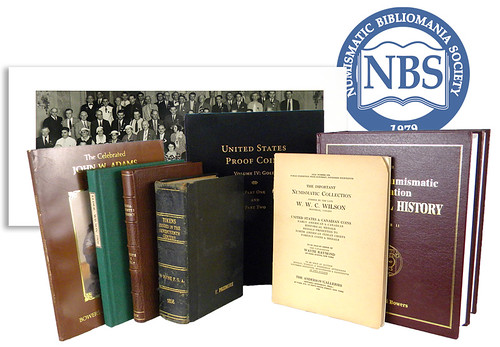
I am delighted to report again this year, the membership stepped forward to ensure the financial health of the NBS through their support of the benefit auction. Our generous donors, enthusiastic bidders and the cataloging efforts of David and Maria Fanning produced $7035 for the treasury! The highlight of the auction was lot 14, Virgil Brand’s copy of Thomas Elder’s plated Wilson sale which drew the top bid of $850.
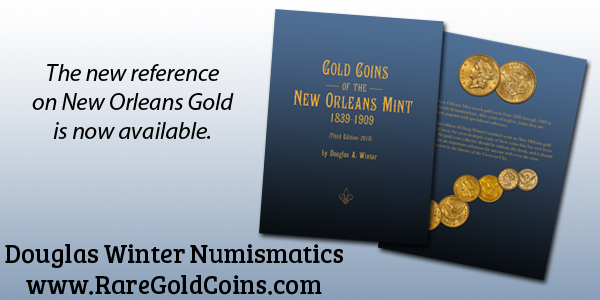
NEW BOOK: WASHINGTON ON COINS AND CURRENCY
A new book from Heinz Tschachler examines George Washington on coins and currency. -Editor
 George Washington on Coins and Currency
George Washington on Coins and Currency
Heinz Tschachler
Format: softcover (7 x 10)
Pages: 246
Bibliographic Info: 35 photos, notes, bibliography, index
Copyright Date: 2020
pISBN: 978-1-4766-8110-8
eISBN: 978-1-4766-4034-1
Imprint: McFarland
George Washington is the most popular subject on coins, medals, tokens, paper money and postage stamps in America. Attempts to eliminate one-dollar bills from circulation, replacing them with coins, have been unsuccessful. Americans’ reluctance to part with their “Georges” are beyond rational considerations but tap into deep-felt emotions. To discard one-dollar bills means discarding the metaphorical Father of His Country.
NEW BOOK: HESSIAN COINS AND MEDALS
A new book has been published (in German) on the coins and medals of the Hessian counties from 1483 to 1803/1806. Here's the Google-translated description from the publisher's website. -Editor
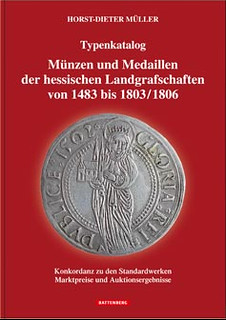 Horst-Dieter Müller
Horst-Dieter Müller
Münzen und Medaillen der hessischen Landgrafschaften von 1483 bis 1803/1806
(Coins and medals of the Hessian counties from 1483 to 1803/1806
Concordance with the standard works, market prices and auction results)
Published by Battenberg Verlag
ISBN: 978-3-86646-187-1
Edition: 1st edition 2019
Images: color throughout
Hardcover: 584 pages
Format: 21 x 29.7 cm
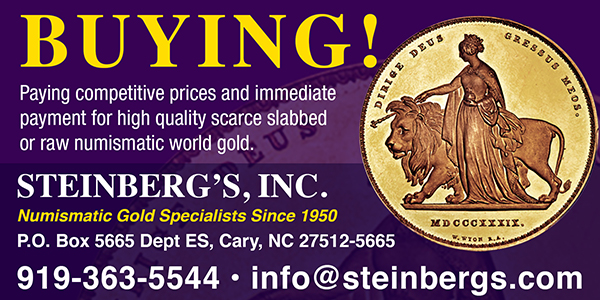
NEW BOOK: NEW ZEALAND MEDALS 1939-40
Martin Purdy writes:
"After compiling several printed catalogues of New Zealand commemorative medals and challenge coins, the team from the Royal Numismatic Society of NZ that I'm part of has adopted a new approach for the next couple of projects on its list: updates to Leon Morel's catalogue of NZ commemorative medals 1865-1940 (2nd ed. 1996, Supplement 2000) and to the MacMaster/Purdy catalogue of post-1940 NZ commemorative medals (2nd ed. 2014) will now be published in sections and made available in digital form as soon as we finish each one.
Part 1 of the Morel project is now complete - it covers just the 1939-40 NZ Centennial items but runs to over 100 pages, thanks to some introductory bits and pieces, and quite generous spacing to allow room for still more discoveries! Subsequent chapters of "Morel 3" and also "MacMaster/Purdy 3" will follow as we finish them, but this is at least a start after a few years in preparation."
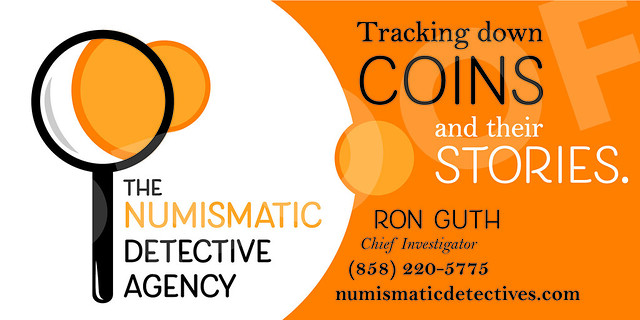
NEW BOOK: DISNEY NUMISMAGIC
Ted Ryan writes:
"I noted your May 15, 2016 E-Sylum article about the discontinuance of Disney Dollars where you stated: "Well, at least we now know what a complete set consists of. Or do we? Have Disney Dollar issues been comprehensively cataloged anywhere? I know there have been some coin show exhibits and articles in numismatic publications. A quick search of the ANA's archive of 'The Numismatist' turned up 94 results for "Disney Dollars" beginning in July 1987."
"I have been working on it and compiling the data for over 30 years now. It has taken much longer than I expected to get the book finally published, but that allowed me to compile even more data.
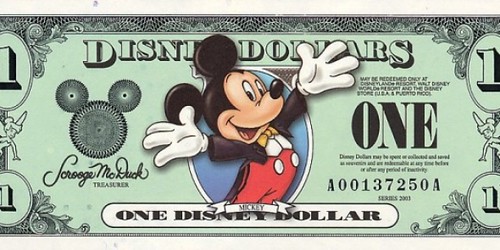
That's great to hear! Here's the press release. -Editor
THE BOOK BAZARRE
NEW BOOK: A GUIDE BOOK OF COLLECTIBLE POSTCARDS
Whitman Publishing has released a new book by Dave Bowers and Mary Martin on collecting postcards. This was a sideline hobby of mine for many years. I built a nice little collection of postcards picturing scenes from my hometown of Pittsburgh which I later donated to the local Heinz History Center. I still have other numismatic-themed postcards in my numismatic ephemera collection. You can be sure Dave didn't neglect the numismatic connection in the new book. Here's the media release. -Editor
A Guide Book of Collectible Postcards, by Bowers and Martin
New Book Will Appeal to Coin Collectors and Other Hobbyists
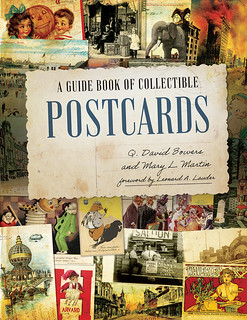 Whitman Publishing announces the release of A Guide Book of Collectible Postcards, by Q. David Bowers and Mary L. Martin. The 432-page book will be available for preorder Labor Day weekend, 2020. In mid-September it will be available from booksellers and hobby shops nationwide and online (including at www.Whitman.com) for $39.95.
Whitman Publishing announces the release of A Guide Book of Collectible Postcards, by Q. David Bowers and Mary L. Martin. The 432-page book will be available for preorder Labor Day weekend, 2020. In mid-September it will be available from booksellers and hobby shops nationwide and online (including at www.Whitman.com) for $39.95.
Postcard collecting has been a popular American pastime since the hobby’s Golden Age (the 1890s through World War One). For today’s collector, postcards offer historic photography, snapshots of pop culture and everyday life, colorful works by famous artists—and the thrill of the hunt while building a collection.
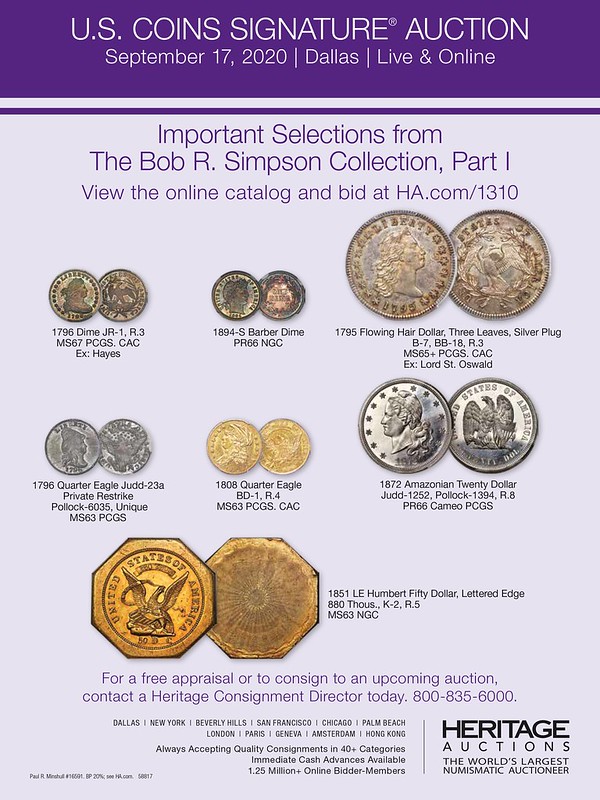
RICHARD J. PLANT (1928-2020)
Frederick A. Liberatore writes:
"Richard J. Plant, author most recently of "Greek, Semitic, Asiatic Coins and How to Read Them" (revised and augmented 2013) died in early August at the age of 92. A review of this book was published in The E-Sylum to alert numismatists of a new and useful publication. Readers are likely familiar with Richard's other two well-known books, "Arabic Coins and How to Read Them" and "Greek Coin Types and Their Identification."
All of these books feature information generally hard to find elsewhere as well as thousands of his remarkable hand drawn illustrations of the coins under study. The publisher of the 2013 2nd edition on reading coin legends sent me the final copy from Grandad Press #91. The book is now officially out of print. Lucky purchasers own a treasure."
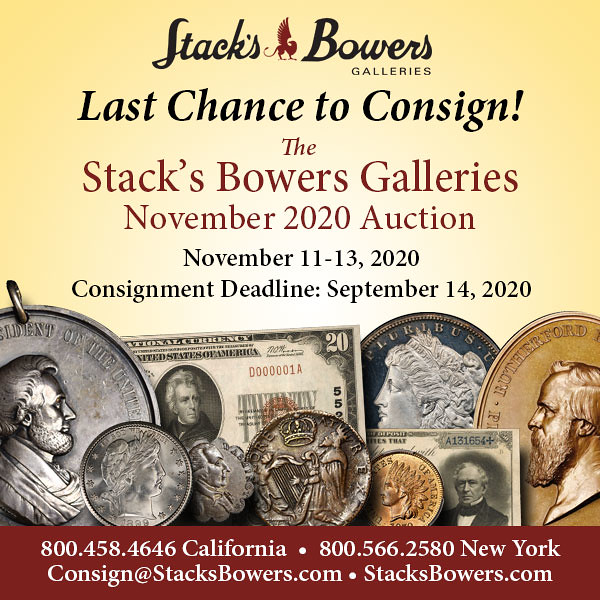
ANS CHAPMAN-TREMBLAY CORRESPONDENCE DIGITIZED
The latest addition to the Newman Numismatic Portal is Chapman correspondence with P. O. Tremblay. Project Coordinator Len Augsburger provided the following report. -Editor
American Numismatic Society Chapman Correspondence Digitized
After a hiatus of several months, due to the epidemic, scanning of the Chapman correspondence at ANS has resumed on a full-time basis. Sponsored by Newman Numismatic Portal, scanner Lara Jacobs is now up to the letter “V,” representing approximately 2,000 correspondents to date. Samuel H. and Henry Chapman, brothers, operated as numismatic dealers in Philadelphia, c. 1880-1935.
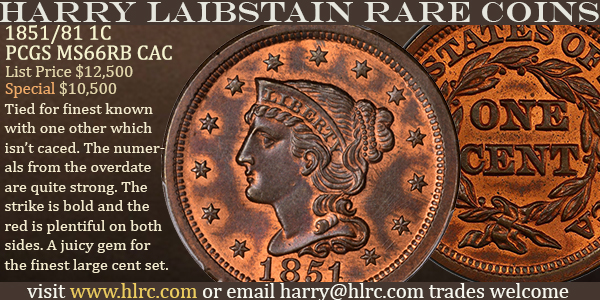
VIDEO: IRAJ SAYAH INTERVIEW
These are selections from the David Lisot Video Library that feature news and personalities from the world of coin collecting. David has been attending coin conventions since 1972 and began videotaping in 1985. The Newman Numismatic Portal now lists all David’s videos on their website at:
https://nnp.wustl.edu/library/multimediadetail/522852
Here's an interview with Iraj Sayah. -Editor
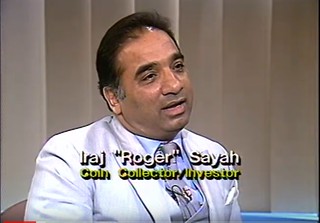 PNG Living History: Iraj Sayah, July 12, 1988.
PNG Living History: Iraj Sayah, July 12, 1988.
Sponsored by the Professional Numismatists Guild.
VIDEO: 17:11.
Iraj Sayah was an Iranian businessman who become involved in the numismatic market ending up a few years later as a paradoxical figure due to problems with the Federal Trade Commission. When Iraj first got into coins he explains to David Lisot, who was a reporter for the Financial News Network, why he chose coins as an area in which to invest. He compares coins to other markets and why he believes the American coin market is the best. Iraj Sayah was a major force in numismatics holding Friendship Parties and Numismatic Symposiums. Another colorful character in the coin market!
An excerpt of the video is available for viewing on the Coin Television YouTube Channel at:
https://youtu.be/1jRBiCuRDRo
VIDEO: RON GUTH DISCUSSES ALICE PAUL
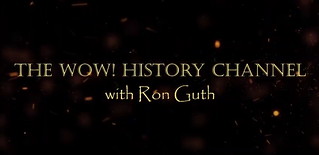
Ron Guth has a new Wow! History YouTube channel. In the 4th episode, he discusses Alice Paul and her connection (or lack thereof) to Chester Arthur and his First Spouse coin. Nice library! -Editor
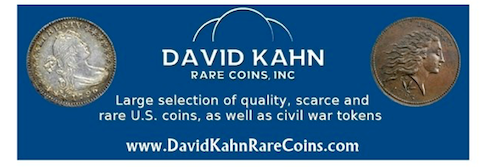
NOTES FROM E-SYLUM READERS: SEPTEMBER 6, 2020
Topics this week include dealer Charles Steigerwalt, Victor David Brenner sculptures, the 1865 Grand Review of the Armies Medal, and an archeological discovery in Israel -Editor
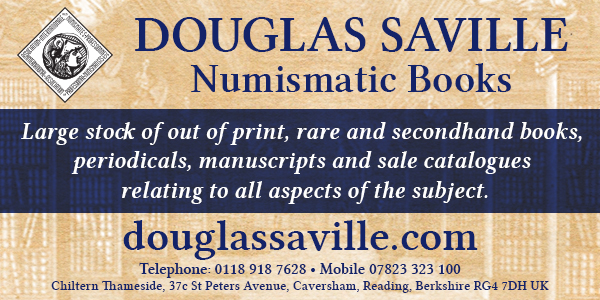
CONFEDERATE TREASURY MEXICAN COIN
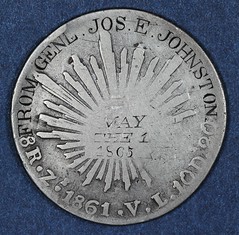 The Confederate Treasury included a large quantity of Mexican silver 8 reales coins. At the war's end the Treasury was shipped south from Richmond by rail, and along the way Confederate notes were redeemed for silver coin at the rate of 70 to 1. The remaining coins were paid out to escorting troops. Some of the coins were kept as souvenirs of the war and later engraved.
The Confederate Treasury included a large quantity of Mexican silver 8 reales coins. At the war's end the Treasury was shipped south from Richmond by rail, and along the way Confederate notes were redeemed for silver coin at the rate of 70 to 1. The remaining coins were paid out to escorting troops. Some of the coins were kept as souvenirs of the war and later engraved.
Website visitor Chelius H. Carter of Fredericksburg, VA passed along images of a coin he recently purchased with accompanying documentation stating that it had been paid to a soldier in the 2nd Tennessee Cavalry. Thanks - very interesting! Can anyone add further information? Links to earlier E-Sylum articles are included below, and some of those mention references. -Editor
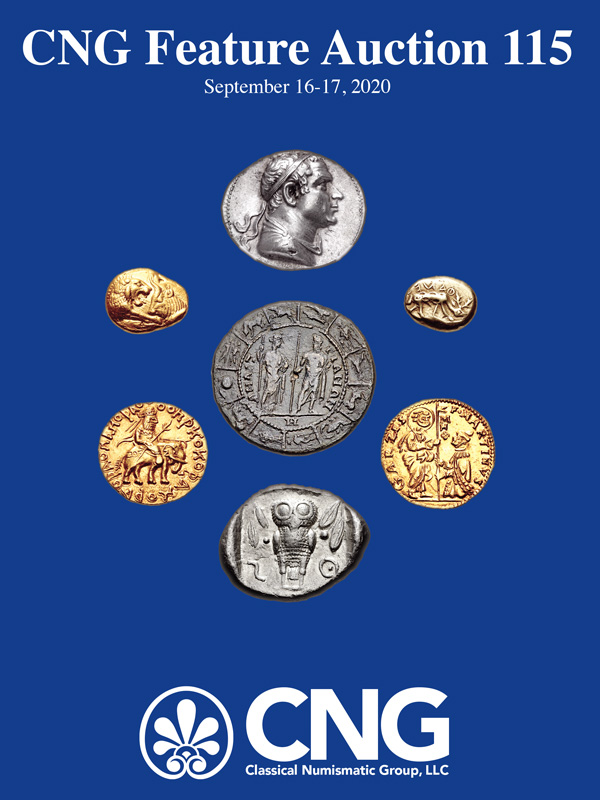
STANDING LIBERTY GAME COUNTERS
Jorge L. Crespo Armáiz of the Puerto Rico Numismatic Society poses a question for readers about game counters resembling the Standing Liberty quarter. Can anyone help? -Editor
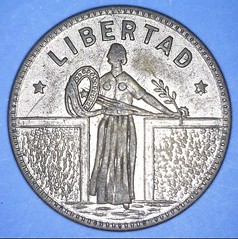 I’m researching and working on an essay on a rare type of game counters or tokens that resemble or imitate the Standing Liberty Quarter. These are crude pieces that in the obverse present the Spanish legend LIBERTAD.
I’m researching and working on an essay on a rare type of game counters or tokens that resemble or imitate the Standing Liberty Quarter. These are crude pieces that in the obverse present the Spanish legend LIBERTAD.
I wonder if readers could be so kind helping in finding if there are articles related to these pieces. The major mystery is regarding their origin, particularly since they have a prominent Spanish legend, while on the reverse some varieties show English denominations (like VALUE 25c).
ORMSBY'S 1857 BANK NOTE ENGRAVING PAMPHLET
At my request book dealer Gil Parsons kindly provided this excerpt from the anniversary catalog of his firm Parsons Books. Last week we looked at one of the rarest books on U.S. paper money, Waterman Lilly Ormsby's 1852 work on banknote engraving. This week we examine an even more rare item - Ormsby's 1857 pamphlet. Thank you! -Editor
ORMSBY, W.L. The Administration of the Bank Department of the State of New York on the Subject of Bank Note Engraving containing details of my correspondence and experience with various Superintendents and a variety of valuable information on the subject of the prevention of counterfeiting
New York: John H. Duyckinck Printer, 1857
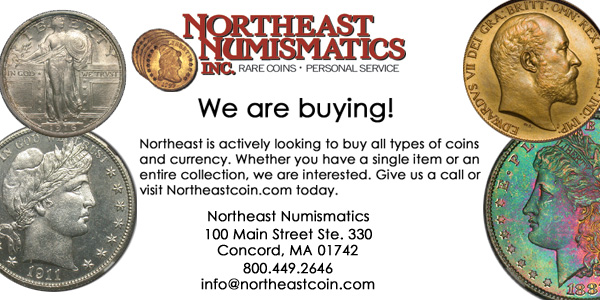
VOCABULARY TERM: MONEYER
Dick Johnson submitted this entry from his Encyclopedia of Coin and Medal Terminology. Thanks. -Editor
Moneyer. An early coiner; a person who made coins before minting plants were established, during the Industrial Revolution. Moneyers were granted authority by a king or some municipal official to strike coins for a specified area. Their pay was typically one coin for every twelve produced, called brassage. Moneyers faced two problems: a supply of blanks –sometimes cast or cut from beaten plates of metal (see blanking) – and engraving the dies for the moneyer to strike (see dies and diemaking). They would strike coins between the dies with a heavy blow from a hammer, one die secured in an anvil, the other held by the coiner. In numismatics this is known as hammered coinage. As technology advanced, the manufacture of coins moved from the workroom of a moneyer to a building specifically intended for the production of coins, a mint, and from a moneyer with an assistant or two, to craftsmen with specialized tasks (see mints and minting).
FERGUSON HAINES (1840-1925)
John Lupia submitted the following information from the online draft of his book of numismatic biographies for this week's installment of his series. Thanks! As always, this is an excerpt with the full article and bibliography available online. This week's subject is collector/dealer Ferguson Haines. -Editor
Haines, Ferguson (1840-1925), Businessman, Politician, and Coin Dealer, 67 Adams Street, Biddeford, York County, Maine.
He was born at Saco, Maine on March 2, 1840, son of William Pickering (1811-1879) and Harriet (Ferguson) Haines (1814-1896). He married Hattie Hill (1840-) on June 1, 1865. He died on May 8, 1925.
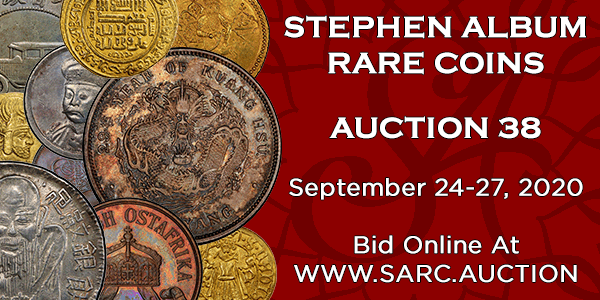
ANS SEEKS CURATORIAL ASSISTANT
The ANS is looking to hire a curatorial assistant. Here's the position announcement. Great opportunity to work at a world-class numismatic institution. -Editor
Curatorial Assistant
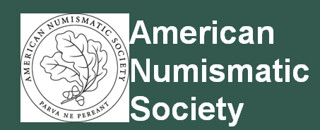 September 1, 2020
September 1, 2020
The American Numismatic Society (ANS) is seeking to hire a Curatorial Assistant, who will organize the disposition of duplicate items. The Curatorial Assistant will work with portions of the curatorial collection and assist the staff in cataloguing and in the de-accessioning process. We seek an energetic self-starter with the ability and desire to institute a direct sales and marketing program for the ANS, a non-for-profit museum and research organization in New York City. The successful candidate will set up and manage an online store. The ANS will provide training in registration, photography, and numismatics if needed.
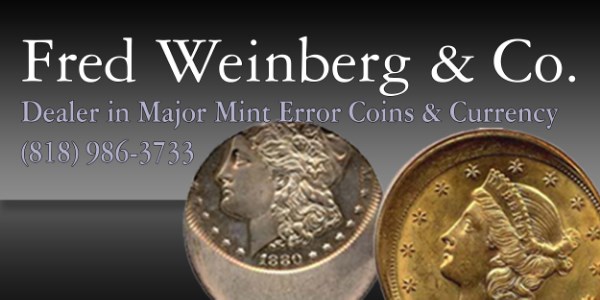
STEPHEN ALBUM RARE COINS AUCTION 38
Here's the press release for Stephen Album Rare Coins upcoming Auction 38. -Editor
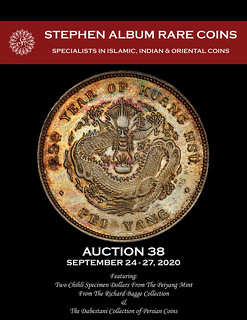 Stephen Album Rare Coins will hold its Auction 38 on September 24-27, 2020 at its offices in Santa Rosa, California. The auction is made up of an even 4,000 lots of Ancient, Islamic, Chinese, General World, and Indian Coins.
Stephen Album Rare Coins will hold its Auction 38 on September 24-27, 2020 at its offices in Santa Rosa, California. The auction is made up of an even 4,000 lots of Ancient, Islamic, Chinese, General World, and Indian Coins.
Featured in this sale are two Chihli Specimen Dollars from the Peiyang Mint form the Richard Bagge Collection. The two Chihli dollars are the first of the year 29 Peiyang dollars graded by the major grading companies as specimens. The Peiyang mint had just been rebuilt in 1902, necessitated by its destruction during the Boxer Rebellion. These dollars were likely gifts to Richard Bagge, a Swedish diplomat based in Shanghai, upon the reopening of the mint. These coins are of the utmost rarity and we feel are conservatively estimated. They are sure to be a major highlight.
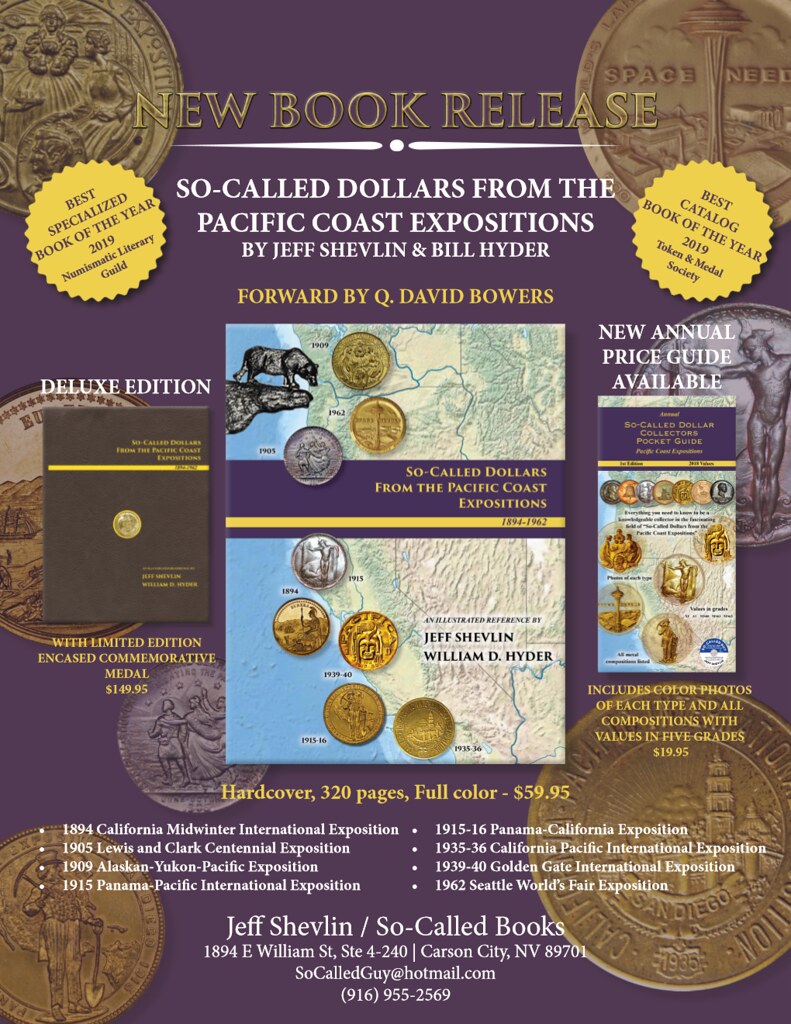
NUMISMAGRAM MEDAL SELECTIONS: SEPTEMBER 2020
Numismagram's Jeremy Bostwick forwarded along these highlights from among the selections recently added to his website at the beginning of the month. In addition to these new art medals and plaques, he will also be featuring an assortment of medallic works from the hand of Swedish sculptor-engraver Erik Lindberg (famous for his design of the Nobel Prize award medals and related nominating committee medals) later this month, so stay tuned to numismagram.com/inventory for all of these new additions. -Editor
Banská Štiavnica Mining Academy Medal
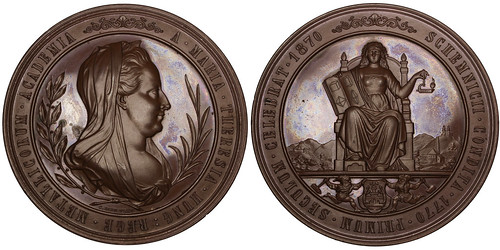
101205 | AUSTRIA-HUNGARY. Mining Academy bronze Medal. Issued 1870. Commemorating the 100th anniversary of the academy in Banská Štiavnica (69mm, 107.39 g, 12h). By C. Radnitzky. A • MARIA • THERESIA • HUNG : REGE • METALLICORUM • ACADEMIA, diademed, veiled, and draped bust of Maria Theresia right between wreath of palm frond and laurel branch / SCHEMNICII • CONDITA • 1770 • PRIMUM • SECULUM • CELEBRAT • , Hungaria seated facing on throne, holding miner's lamp and open mineralogy book; countryside with factories and mines in background; in exergue, coat-of-arms with dwarven supporters. Edge: Plain. Hauser 1645; Serfas 305; Montenuovo –; Wurzbach 6044; Preussag Coll. II, 1631. Gem Mint State. Glossy chocolate brown surfaces, with an intense degree of radiating luster; a few light spots on the obverse are noted for completeness. $325.
A town tied to mining since antiquity, Banská Štiavnica was mentioned by Roman authors for her silver ore mined there by the Celts, and was the main producer of silver and gold for the Kingdom of Hungary during the Middle Ages. In 1627, it became one of the first places where gunpowder was used for blasting. This medal commemorates the centennial of an academy established there in 1770 in the field of mineralogy.
Dwarven supporters! A beautiful and interesting piece. -Editor
To read the complete item description, see:
101205 | AUSTRIA-HUNGARY. Mining Academy/Maria Theresia bronze Medal.
(https://www.numismagram.com/product-page/101205)
Ernst Otto Theodor Westerlund Medal
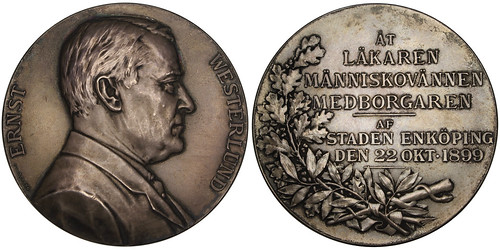
101233 | SWEDEN. Ernst Otto Theodor Westerlund silver Medal. Issued 1899. Commemorating the 60th birthday of the physician (56mm, 76.75 g, 12h). By A. Lindberg. ERNST WESTERLUND, bust right / ÅT / LÄKAREN / MÄNNISKOVÄNNEN / MEDBORGAREN / AF / STADEN ENKÖPING / DEN 22 OKT • 1899 in seven lines; oak and laurel branch curled to left, with serpent-entwined staff below. Edge: Plain. Brettauer –; Storer 3768. Choice Mint State. Pleasingly toned on the obverse, with a somewhat lighter nature on the reverse, and attractively matte throughout. $295.
Born in 1839 in Öregrund, Ernst Westerlund was thrust into the role of provider for his household at a very young age due to the early deaths of his father and siblings. He studied at Uppsala University, where he received his degree in medicine in 1867. Following the death of the city doctor in Enköping in that year, Westerlund took over the role, quickly developing a name as a skillful gynecologist as well as a neurologist. The name of "Enköpingsdoktorn" was bestowed upon him, and he continued to receive patients not only from around Sweden, but from Finland, Norway, Denmark, and even Russia. One such Russian patient was Count Lev Tolstoy, son of the famous "War and Peace" author by the same name. While under the care of Westerlund, he fell in love with the latter's daughter, Dorothea (Dora), marrying her in 1896 and ultimately settling there during the early years of World War II. Westerlund continued his practice in Enköping until his death in 1924 at the age of 84, having served the community for nearly 57 years.
To read the complete item description, see:
101233 | SWEDEN. Ernst Otto Theodor Westerlund silver Medal
(https://www.numismagram.com/product-page/101233)
Jan Kolda Medal
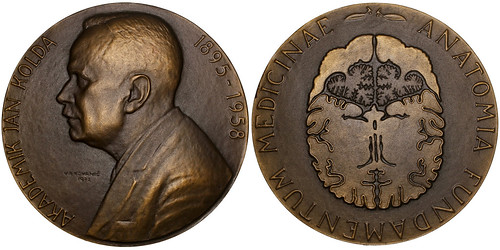
101249 | CZECHOSLOVAKIA. Jan Kolda bronze Medal. Issued 1972. Commemorating the life of the comparative anatomist and professor (60mm, 86.44 g, 12h). By V. A. Kovanic. AKADEMIK JAN KOLDA 1895–1958, bust left / ANATOMIA FUNDAMENTUM MEDICINAE, view of a human brain from the top. Edge: Plain. Gem Mint State. Brown-bronze surfaces, with a great matte nature. Highly interesting anatomical type. $185.
A comparative anatomist and professor, Jan Kolda passed away on 29 November 1958 in Doubravník. His lengthy career can be best summed up by fellow veterinarian and professor, Cenek Cervený, following Kolda's death: "The work he performed to the benefit of Czech and world-veterinary morphology, is enormous. He was an excellent university teacher, he compiled the first Czech textbook of veterinary anatomy, developed scientific activities on a wide basis and educated many successful followers. He built the Anatomical Institute and a magnificent anatomical museum. He laid solid foundations to Czechoslovak veterinary morphology."
A brainy piece. -Editor
To read the complete item description, see:
101249 | CZECHOSLOVAKIA. Jan Kolda bronze Medal.
(https://www.numismagram.com/product-page/101249)
Johan August Wahlberg Medal
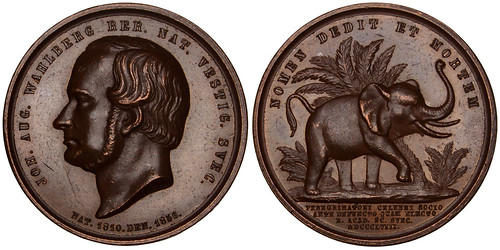
101218 | SWEDEN. Johan August Wahlberg bronze Medal. Issued 1858. Honoring the naturalist and explorer (31mm, 10.79 g, 12h). By L. Ahlborn. JOH AUG WAHLBERG RER NAT VESTIG SVEC, bare head left / NOMEN DEDIT ET MORTEM, elephant trumpeting right; in four lines in exergue, PEREGRINATORI CELEBRI SOCIO / ANTE DEFUNCTO QUAM ELECTO / R ACAD SC SVEC / MDCCCLVIII. Edge: Plain. Olsén 133; Laidlaw 0024. Mint State. Charming red-brown surfaces, with some brilliance in the fields and just a hint of rub on the high points. $225.
A Swedish naturalist and explorer, Johan August Wahlberg graduated with a degree in chemistry from Uppsala University in 1829, and later in forestry and agronomy in 1834. Beginning in 1838, Wahlberg embarked upon an exploratory trip to southern Africa where he collected countless specimens of natural history to be sent back to Sweden for study. While in what is now Botswana, Wahlberg was tragically killed by a wounded elephant. As news of his death had not yet reached Sweden, he had, in the meantime, been elected to be a member of the Royal Swedish Academy of Sciences, making him the only member to have been elected posthumously.
Ironic combination of images, but a great elephant nonetheless. -Editor
To read the complete item description, see:
101218 | SWEDEN. Johan August Wahlberg bronze Medal.
(https://www.numismagram.com/product-page/101218)
Endicott New York Firemen's Convention Badge
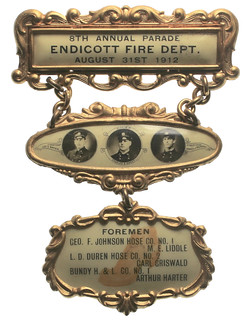 101320 | UNITED STATES. Endicott, New York. Brass Parade Badge.
Issued 1912 for the 8th annual Tri-Village Firemen's convention & parade (65x92mm, 16.71 g). Three clasps, each decorated with scrolled border; the top reading: "8TH ANNUAL PARADE / ENDICOTT FIRE DEPT. / AUGUST 31ST 1912 in three lines;" the middle displaying: vignettes of Chief Charles E. Sweet between First Assistant Chief Lee E. Baker and Second Assistant Chief James J. Murphy; the bottom reading "FOREMEN / GEO. F. JOHNSON HOSE CO. NO. 1 / M. E. LIDDLE / L. D. DUREN HOSE CO. NO. 2 / CARL GRISWALD / BUNDY H. & L. CO. NO. 1 / ARTHUR HARTER" in seven lines; image of shoe in background. Essentially as issued, though reverse pin has been replaced at the top, with the two others missing. A great piece of Americana from New York's Southern Tier. $295.
101320 | UNITED STATES. Endicott, New York. Brass Parade Badge.
Issued 1912 for the 8th annual Tri-Village Firemen's convention & parade (65x92mm, 16.71 g). Three clasps, each decorated with scrolled border; the top reading: "8TH ANNUAL PARADE / ENDICOTT FIRE DEPT. / AUGUST 31ST 1912 in three lines;" the middle displaying: vignettes of Chief Charles E. Sweet between First Assistant Chief Lee E. Baker and Second Assistant Chief James J. Murphy; the bottom reading "FOREMEN / GEO. F. JOHNSON HOSE CO. NO. 1 / M. E. LIDDLE / L. D. DUREN HOSE CO. NO. 2 / CARL GRISWALD / BUNDY H. & L. CO. NO. 1 / ARTHUR HARTER" in seven lines; image of shoe in background. Essentially as issued, though reverse pin has been replaced at the top, with the two others missing. A great piece of Americana from New York's Southern Tier. $295.
Emerging as one of the "Triple Cities" in the Southern Tier of New York, Endicott was the final of these three triplets (the others being Binghamton and Johnson City) to be established, incorporated largely as a company town in 1906. The source of the village's early boom was shoes—namely, the Endicott-Johnson Shoe Company, which rapidly grew to become one of the largest shoe manufacturers in the nation, even supplying nearly all of the footwear for America's war efforts in World Wars I and II. "E-J" quickly became a highly sought-after employer on account of the "square deal" promoted by company president and partner, George F. Johnson. Employment, though piecemeal, offered medical benefits and the first 8-hour workday/40-hour workweek in the shoe industry. Additionally, activities and attractions for the workforce outside of the job were created, such as libraries, parks, pools, parades, and even company built homes.
This badge was for the 8th annual parade for the association of firemen from the "tri-villages" of Endicott, Union, and Johnson City (then still known as Lestershire), with 1912 being the inaugural year for the creation of Endicott's fire department. Notable firefighting companies among the parade's foremen included the George F. Johnson Hose Co. No. 1 (named after the aforementioned G. F. Johnson), the L. D. Duren Hose Co. No. 2, and the Bundy Hook and Ladder Co. No. 1 (named for Harlow E. Bundy, a nearby resident of Binghamton who mass produced his brother's invention of the time clock and whose subsequent business—the Bundy Manufacturing Co.—was eventually amalgamated into what would become IBM). Adding even more local flair, a shoe—emblematic of Endicott itself at the time—is subtly displayed in the background.
Unusual, rarely-seen item, -Editor
To read the complete item description, see:
101320 | UNITED STATES. Endicott, New York. Brass Firemen's Parade Badge.
(https://www.numismagram.com/product-page/101320)
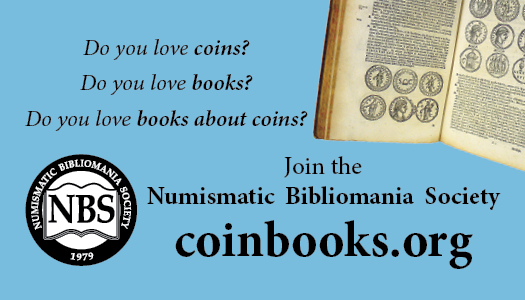
ARTIST RENDERINGS OF SRI LANKA TOKEN IMAGES
I enjoyed my friend Kavan Ratnatunga's presentation on the coins and currency of Sri Lanka at last week's NNP Symposium. I especially liked the artist renderings he displayed - they make it much easier to understand the coin images and inscriptions. A number of these images are displayed on Kavan's website. Here's an excerpt. -Editor
These lead tokens were found in last two decades of 20th century, buried around Tissamaharama in Sri Lanka and are dated to 200 BCE. to 200 CE. Lead is used in many of early coins because probably of low melting point. Most are unique and not found in hoards, so unlikely to be coins. They maybe tokens buried in the foundation of houses as is the custom even today. They are very small weighing few grams at most and less than an inch in diameter.
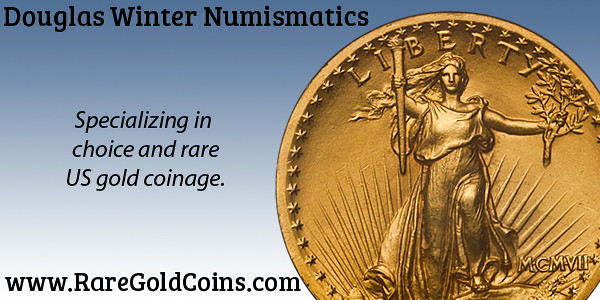
CHINESE SPECIMEN SILVER COINS OFFERED
An article elsewhere in this issue highlights lots in the upcoming Stephen Album Rare Coins Auction 38. This article from NGC discusses an interesting pair of specimen coins in the sale. -Editor
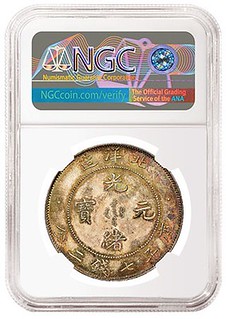 Numismatic Guaranty Corporation® (NGC®) certified a pair of exceptional Chinese Specimen silver coins that will be offered by Stephen Album Rare Coins in its Auction 38, being held September 24-27, 2020. Both coins are Specimen Year 29 (1903) Chihli “Period After Yang” L&M-462 Silver Dollars.
Numismatic Guaranty Corporation® (NGC®) certified a pair of exceptional Chinese Specimen silver coins that will be offered by Stephen Album Rare Coins in its Auction 38, being held September 24-27, 2020. Both coins are Specimen Year 29 (1903) Chihli “Period After Yang” L&M-462 Silver Dollars.
Specimens are coins struck with special care to accentuate the strike and protect their surfaces. While they don’t quite meet the criteria to be called Proof, Specimens are clearly distinct from circulation strikes. Both of these Specimen coins have exceptional surfaces, strong strikes and amazing original toning.
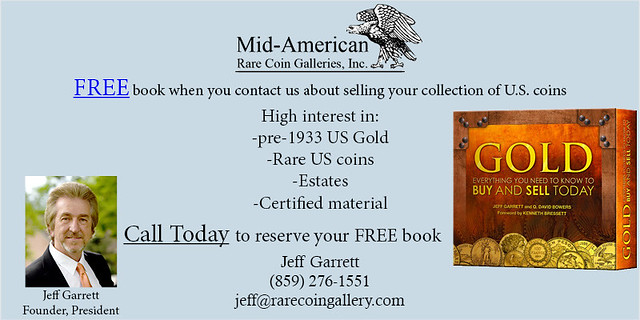
AMAZONIAN TWENTY DOLLAR ALUMINUM PATTERN
Heritage Auctions sent this press release for their upcoming sale of an Amazonian Double Eagle pattern in aluminum. -Editor
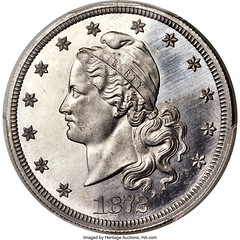
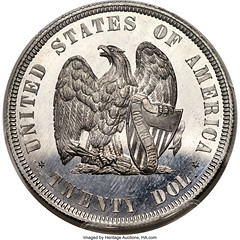
Rare Pattern From When Aluminum Outranked Gold
Aluminum is so ubiquitous today that it may not strike you today as a metal that would belong on the "precious metals" list or that even has much value. However, in the early and mid-1800s, it was considered in the United States and Europe to be very precious indeed. This led to the production of some rare pattern coins (trial pieces made to test out new designs or metal compositions) struck in aluminum. In fact, for a time during the 1800s, aluminum was more valuable than gold!
ASSAY OFFICE EAGLE FRACTIONAL GOLD PIECE
Another Heritage Auctions press release is for their upcoming sale of a nice California fractional gold piece. -Editor
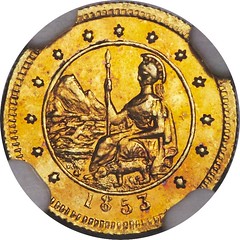
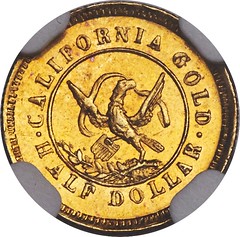
Small In Stature, But a Big Deal For Collectors
California Fractional Gold coins are artifacts of Gold Rush history that were created to solve the lack of coinage in circulation that occurred when gold was found in the West in the 1840s and 50s. While there were not enough coins to keep commerce running smoothly (as the West was far from most of the operational mints creating coins at the time and "off the beaten path" for most trade), there was plenty of gold metal--mostly impractical gold dust.
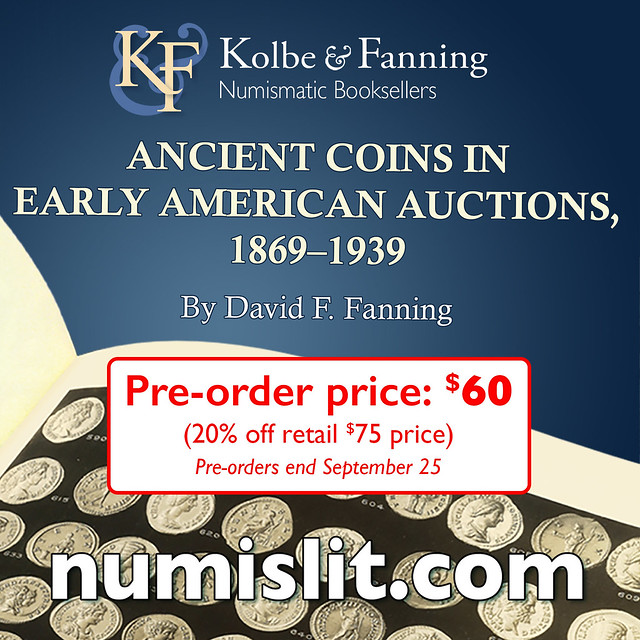
THE LAST ENCASED POSTAGE STAMP ISSUER
Dave Bowers beat me to it - I was already planning to mention the numismatic connection to Lord & Taylor, the recently bankrupted store chain. -Editor
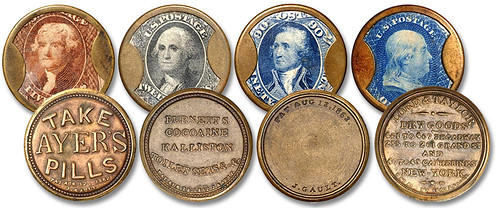
Lord & Taylor, the famous fashion retailer, is no longer with us, or at least not in its usual form. On August 3 the firm announced Chapter 11 bankruptcy protection and stated it planned to close all 24 of its stores.
Numismatically, Lord & Taylor is well-remembered for its issuance of encased postage stamps. In the second week of July 1862, with no silver or gold coins in sight, and the channels of commerce awash in paper bills, even copper-nickel cents were hoarded. It was impossible to find a coin to buy a newspaper, get a haircut, or take a ride on a horse-drawn car. Breaching the gap, many merchants, towns, and others issued tickets imprinted with values from one cent onward; paper money scrip notes with three cents and five cents were the most popular, but other values went up to a dollar or more. In time, many merchants issued bronze tokens, the size of a cent, which served for that value.
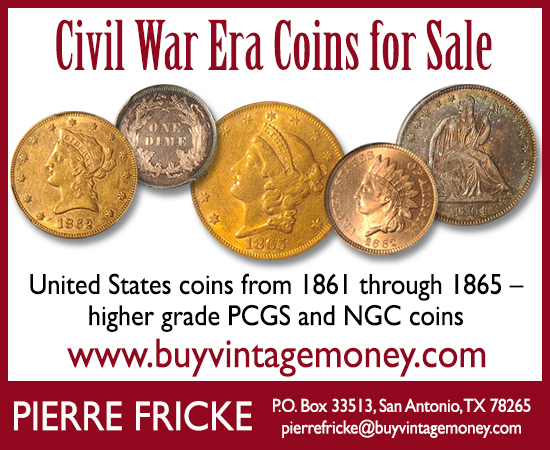
AUSTRALIA'S DONATION DOLLAR
In the how-RUDE-to-even-THINK-about-collecting-this-one department, Kavan Ratnetunga and Pabitra Saha forwarded this article about Australia's new "Donation Dollar". Interesting concept. -Editor
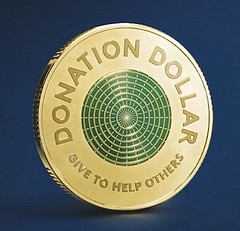 The Royal Australian Mint has released a new coin that’s designed to be donated.
The Royal Australian Mint has released a new coin that’s designed to be donated.
The Mint unveiled the Donation Dollar as part of a world-first donation initiative. While the dollar is legal tender, the Mint is encouraging Aussies to use it wherever cash donations are accepted to help people or organisations that are in need.
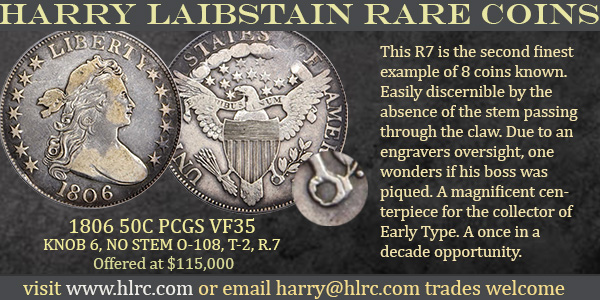
HOW AMERICA FELL INTO A GREAT COIN SHORTAGE
The Washington Post published a story this week on the nationwide coin shortage. Here's an excerpt. Great cartoon. -Editor
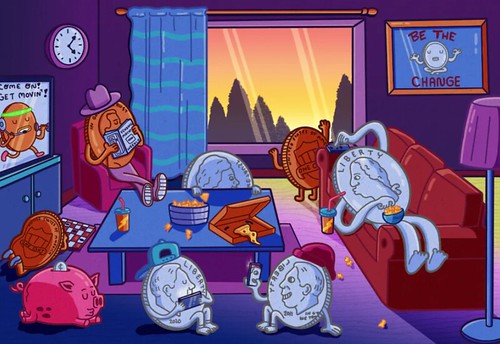
In yet another 2020 plot twist, coins aren’t making their way through the economy, with the repercussions rippling from the upper echelons of the federal government down to ice cream shops and bank teller windows. With more people staying home, buying less and shifting their spending online, the natural flow of pocket change through banks, restaurants and retail stores has dried up.
TSA REPORTS FINDING $1M IN MISPLACED CASH
In the find-a-penny-take-a-penny department, the TSA reports finding nearly a million dollars in left-behind passenger cash during the 2019 fiscal year. Found via the News & Notes newsletter by the Society of Paper Money Collectors (Volume VI, Number 10, August 25, 2020). -Editor
 The Transportation Security Administration collected nearly $1 million in unclaimed money passengers left behind after going through security checkpoints.
The Transportation Security Administration collected nearly $1 million in unclaimed money passengers left behind after going through security checkpoints.
The agency added up $926,030.44 in loose change and paper money from passengers during the 2019 fiscal year, $18,899.09 of which came from foreign currency.
THE BOOK BAZARRE
TRASH ISLES MICRONATION BANKNOTES
We've often discussed the coins and banknotes of micronations. Kavan Ratnatunga passed along articles about promotions for a new micronation created by activists to draw attention to a big environmental problem. This one was found on the International Bank Note Society forum. Thanks. The articles date from 2017 and I don't see much about it online since 2018, so I don't know where the effort stands today. But it's absolutely in the grand tradition of micronation lore. Where are the banknotes today? Were they sold as a fundraiser? -Editor
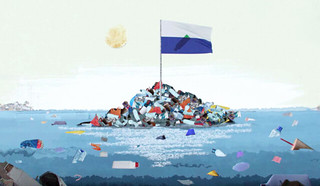 Floating in the North Pacific Ocean is a mountain of waste the size of France. The Great Pacific Garbage Patch is made up of two masses of rubbish between the US and Japan and contains everything from LEGO bricks to computer monitors and fishing nets.
Floating in the North Pacific Ocean is a mountain of waste the size of France. The Great Pacific Garbage Patch is made up of two masses of rubbish between the US and Japan and contains everything from LEGO bricks to computer monitors and fishing nets.
This pollution has had a devastating effect on marine life (around 1 million seabirds die from encountering plastic waste each year) – so media site LADbible has joined forces with The Plastic Oceans Foundation to do something about it.
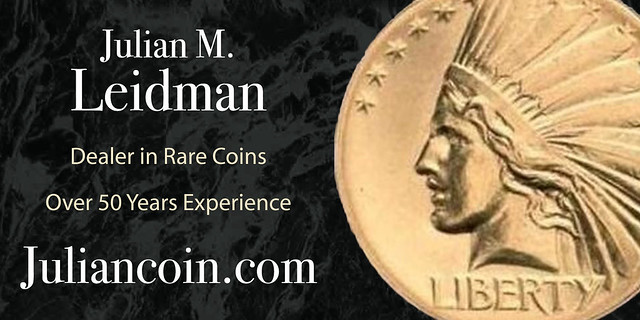
MONEY ART IN CANCELLED WHITNEY EXHIBIT
A young artist's money artwork got caught up in a kerfuffle over a planned exhibit at New York's Whitney Museum of American Art. -Editor
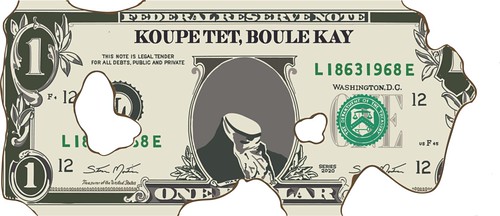
Steven Montinar’s digital drawing “Koupe Tet, Boule Kay” (2020) was among the works selected for the Whitney Museum’s exhibition Collective Actions: Artist Interventions In a Time of Change (image courtesy of Steven Montinar)
375-YEAR-OLD TREE SURVIVES HURRICANE
Numismatists love history, and I think readers will enjoy this story even though the only numismatic connection is the mention of gold doubloons. -Editor
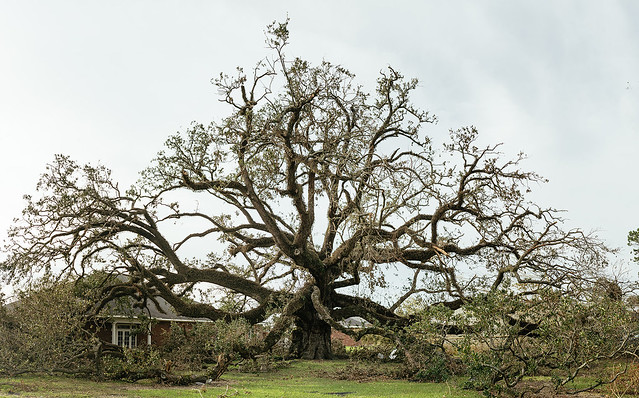
When Hurricane Laura made landfall last week in Lake Charles, Louisiana, as a category 4 hurricane, it unleashed destruction all around. But there was one thing it could not destroy: The Sallier Oak.
LOOSE CHANGE: SEPTEMBER 6, 2020
Here are some additional items in the media this week that may be of interest. -Editor
U.S. and Royal Mints Mayflower Anniversary Sets
As discussed earlier, the U.S. and Royal Mints have issued joint anniversary coinage sets commemorating the voyage of the Mayflower. -Editor
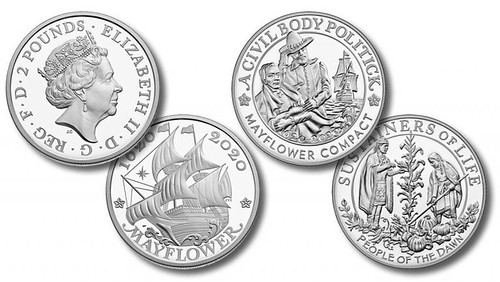
The United States Mint and The Royal Mint (United Kingdom) have collaborated to create two limited-edition sets marking the 400th anniversary of the Mayflower voyage.
The story of the Mayflower is one that connects multiple communities, cultures, and countries. This transatlantic voyage brought 102 Pilgrims and migrants from Europe across the Atlantic and established a new foundation for governance in the New World.
The United States Mint and The Royal Mint have produced a joint two-coin gold proof set and a silver coin and medal proof set that will be released for sale this fall.
The coin and medal designs come together to tell the story of the Pilgrims, the Mayflower‘s journey, and the impact the Pilgrims’ arrival had on the native Wampanoag people.
The reverse of the U.K. coins and the U.S. coin and medal contained in the sets were designed by Chris Costello, who used multiple stylistic elements to tie them together. These include the choice of font and North Star on the U.K. coin, which connects to the image of the sun in the U.S. coin, symbolizing a new day. That symbolism is also a reference to the Wampanoag people who inhabited the region, and were known as the "People of the Dawn."
To read the complete article, see:
U.S. and Royal Mints Announce 2020 Mayflower Anniversary Sets
(https://www.coinnews.net/2020/09/04/u-s-and-royal-mints-announce-2020-mayflower-anniversary-sets/)
To read the earlier E-Sylum article, see:
LOOSE CHANGE: APRIL 28, 2019 : The Mint's Legal Authorities
(https://www.coinbooks.org/v22/esylum_v22n17a28.html)
ROYAL MINT COMMEMORATES MAYFLOWER 400TH
(https://www.coinbooks.org/v23/esylum_v23n32a24.html)
Other topics this week include Citizens Coinage Advisory Committee appointee Peter van Alfen, the Dickin Medal, and the history of punctuation. -Editor

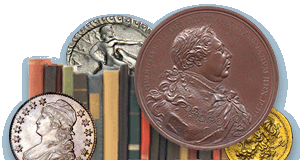
The E-Sylum is an electronic publication of the Numismatic Bibliomania Society
Copyright © 1998 - 2025
